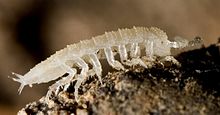Mesoniscus
Appearance
| Mesoniscus | |
|---|---|

| |
| M. graniger | |
| Scientific classification | |
| Kingdom: | |
| Phylum: | |
| Subphylum: | |
| Class: | |
| Order: | |
| Suborder: | |
| Section: | Microcheta Schmalfuss, 1989
|
| Family: | Mesoniscidae Verhoeff, 1908
|
| Genus: | Mesoniscus Carl, 1906
|
| Species | |
| |
Mesoniscus is a
section
, Microcheta. It contains two species – Mesoniscus alpicolus and Mesoniscus graniger – that live in Central and Eastern Europe, mostly in and around caves.
Distribution
Baradla
cave in north-eastern Hungary is home to a population of Mesoniscus graniger.Mesoniscus is restricted to Central Europe and the Balkan Peninsula; the ranges of its two species do not overlap.[1]
M. alpicolus is found in
Northern Calcareous Alps.[1] In Austria, its range extends from the Karwendel near Innsbruck to the eastern edge of the Wienerwald, although it is also found in isolated pockets of Triassic and Silurian–Devonian limestone in Styria.[2]
M. graniger has a wider distribution than its congener; it is found in much of the
Carpathians, including the Bihor and Banat mountains, and in the Dinaric Alps and Julian Alps.[1] It is also found in the Caves of Aggtelek Karst in Hungary.[3]
Taxonomy
The first description of a woodlouse now in the genus Mesoniscus was in 1858, when Camill Heller described "Titanethes alpicolus" in 1858.[4] This was followed in 1865 by the description by János Frivaldszky (Ján Frivaldský) of the subspecies "Titanethes alpicolus graniger".[4]
Mesoniscus is the only genus in the family Mesoniscidae,
Ecology
Mesoniscus species lack the pleopodal lungs found in many other woodlice, and are restricted to damp environments.[7]
References
- ^ a b c Andrei Giurginca (2001). "The spreading of the genus Mesoniscus in the Romanian Carpathians" (PDF). Travaux de l'Institut Spéleologique "Émile Racovitza". 39–40: 11–22.[permanent dead link]
- ^ Hans Strouhal (1951). "Die österreichischen Landisopoden, ihre Herkunft und ihre Beziehung zu den Nachbarländern" [The terrestrial isopods of Austria, their origins, and their relationship to neighbouring countries] (PDF). Verhandlungen der Zoologisch-botanischen Gesellschaft Wien (in German). 92: 116–142.
- ^ Ferenc Vilisics; Antal Nagy; Péter Sólymos; Roland Farkas; Zita Kemencei; Barna Páll-Gergely; Máté Kisfali; Elisabeth Hornung (2008). "Data on the terrestrial Isopoda fauna of the Alsó-hegy, Aggtelek National Park, Hungary" (PDF). Folia Faunistica Slovaca. 13 (4): 19–22. Archived from the original (PDF) on 2013-06-05.
- ^ JSTOR 20102517.
- ^ a b Helmut Schmalfuss (2003). "World catalog of terrestrial isopods (Isopoda: Oniscidea) – revised and updated version" (PDF). Stuttgarter Beiträge zur Naturkunde, Serie A. 654: 341 pp.
- PMID 11072627.
- .
External links
 Data related to Microcheta at Wikispecies
Data related to Microcheta at Wikispecies Data related to Mesoniscidae at Wikispecies
Data related to Mesoniscidae at Wikispecies Data related to Mesoniscus at Wikispecies
Data related to Mesoniscus at Wikispecies
